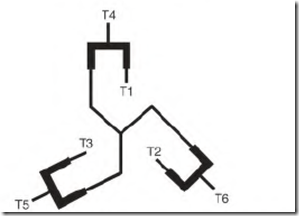Multispeed motors covered in this section have one or more windings. The selected speed operates as a single-speed induction motor. (There is a small amount of slip, which is governed by the rotor design.) They are physically large for their rated horsepower when compared to single-speed induction motors.
Single-Winding Two-Speed Motors
Three types of single-winding two-speed motors are covered in this segment: constant horsepower, constant torque, and variable torque. All have a 2-to-l speed ratio.
The two-speed windings have six leads that are switched and combined by a controller. The constant-horsepower and constant-torque motors use a one-delta and a two-wye combination. The variable-torque motor uses a onewye and a two-wye combination.
The two-wye connection allows more current to flow than the one-delta or one-wye connection. This connection creates high torque (low speed) in the constant-horsepower motor and maintains the same torque (for both speeds) in the constant-torque motor.
The two-speed single-winding motor has a unique coil and pole arrangement. The pole width and spacing allow the motor to be switched from salient pole to consequent pole, and vice versa. Like a DC field pole, the salient pole is a wound pole. When the salient poles are connected so that the adjacent poles are of opposite polarity, the motor is in high speed.
Connecting all the poles of the same polarity creates the consequent-pole winding. Each pole’s width is narrower than normal, leaving a space (iron) between the poles. This iron becomes a consequent pole. As a result, the number of poles is doubled. Doubling the poles cuts the speed in half.
The consequent-pole (low-speed) connection has a much lower power factor than the salient pole connection. It’s common for the consequent-pole connection to draw full (or over) nameplate amperes with no load.
Constant-Horsepower Motor
The constant-horsepower motor has a single horsepower rating on its nameplate, with the same horsepower rating for both speeds. It’s connected two wye for low speed and one delta for high speed (Fig. 5.33).
FIGURE 5.33 Schematic for a constant-horsepower motor.
If a constant-horsepower motor is connected low speed (two wye) and can lift 550 pounds 1 foot in 1 second, it will produce 1 horsepower. Connected high speed, the one-delta connection doesn’t allow as much current to flow (as the two-wye connection). The motor now can lift only 275 pounds, but lifts it 2 feet in 1 second, maintaining 1 horsepower.
The constant-horsepower motor has high torque on low speed and less torque on high speed. It is ideal for a drill press application. A large drill bit needs high torque and should turn slowly. A small drill bit doesn’t require much torque, and normally it is turned at high speed.
Constant-Torque Motor
The constant-torque motor has two horsepower ratings on its nameplate.
The horsepower rating of its high speed is twice that of its low speed.
The connection is one delta for low speed and two wye for high speed.
If a constant-torque motor is connected low speed (one delta) and can lift 550 pounds I foot in 1 second, it is producing 1 horsepower. When connected high speed, the two-wye connection allows more current to flow. More current gives the motor the ability to maintain the same torque, but at twice the RPM of low speed. At high speed, the motor can lift 550 pounds 2 feet in 1 second, producing 2 horsepower.
The constant-torque capability makes the constant-torque motor much more applicable than the constant-horsepower motor.
Variable-Torque Motor
The variable-torque motor has two horsepower ratings on its nameplate. The low-speed horsepower rating is one-fourth that of the high-speed horsepower rating. The variable-torque connection (Fig. 5.34) is one wye on low speed and two wye on high speed. The one-wye (low-speed) connection has onefourth the horsepower that the two-wye (high-speed) connection has. The horsepower/ speed combination is very compatible with the horsepower demands of a fan load.
A 50-horsepower, four- and eight-pole variable-torque motor is an example. Synchronous speeds are used instead of actual nameplate speeds (that involve slip). On high speed (1800 RPM), the motor develops 50 horsepower and is connected two wye. The low-speed (one-wye) connection will develop 12.5 horsepower (0.25 x 50 horsepower) at 900 RPM.
FIGURE 5.34 Schematic for a variable-torque motor. Heavy lines represent phase winding location relative to lead position. This schematic does not show true angle relationship.
When the speed of a fan is changed, the horsepower demand is not in proportion to the speed change. The horsepower must be changed to the cube of the ratio of the speed change. For example,
1800 + 900 — – 2 (ratio) The ratio cubed (or 2 x 2 x 2) = 8
A fan requiring 50 horsepower at 1800 RPM would need only 6.25 horsepower at 900 RPM (50 + 8 = 6.25 horsepower).
Any load requiring this type of horsepower/ speed change ratio has a good potential for considerable savings in power cost. If the motor’s speed can be lowered even a small amount and still meet the output demand, the power consumed will be reduced substantially. Air, liquid, conveyer belt, and auger loads all have similar speed/load power ratios, thus the potential for power cost savings.

